Tuesday, August 29, 2006
Thursday, August 10, Through Saturday, August 12—Paris
We arrived in Paris from Brussels in the early evening on Wednesday. We took a taxi from the train station to our Hostel. We had to do that because I got our reservations near the wrong train station. I wanted to be near the central train station, but I got close to the Nord Station. After we learned to use the Metro (underground rail system) it didn’t really make a lot of difference, because it was only about a ten minute ride from our house to the central station. All the tourists activities are centered around the central train station. Central indicating what they call “City Center” over here. We have learned that if you get lost you can usually find you way to about anything if you can get to the city center. We are staying in an old hotel building. We were on the 2nd floor and I’m glad because there was no elevator. This is the first place we have stayed where the breakfast they served did not appeal to us. Fortunately, there was a McDonalds across the street which had egg McMuffins.
Our hotel didn’t have internet access either. They directed us to an internet café, but it was expensive and you had to use their computers because they did not have wireless. On our first visit there we talked to a lady who told us the McDonalds had free WiFi, but she didn’t have a laptop. We used their free internet the rest of our visit and ate breakfast there everyday. Between the McDonalds and our hotel was an entrance to the Metro. We had only to walk about a hundred yards to get to it. We bought forty eight hour passes which allowed us to ride as much as we wanted to for one price. On Thursday morning we took a city bus tour. It was an on and off tour so we got off and took pictures and got back on the next bus which came along. That works well because the start another tour about every 15 or 20 minutes, so you never have to wait a long time to get another ride. On the second day, Friday, we rode the Metro and walked a lot going back to spend more time at places of special interest.
The history of Paris goes all the way back to a Celtic Gaul Parisii settlement which dates back to about 300 BC. Paris went through rule by the Gauls, the Romans under Julius Caesar, and defended themselves against the Attila the Hun and later the Vikings. Finally in 987 a King was named and the Capetian dynasty was founded. Paris and France became a factor in the world. By the mid 1200’s Paris had two universities. In the mid 1300’s Paris became a walled city when Charles V needed more defense. By the mid 1500”s the quays along the river were built and there were street lights. The 1830’s saw the first French railroad and by 1900 there was a metro underground system in Paris. So much for that little bit of history teacher jumping up on me.
Today Paris has a population of 2,250,000 and covers an area of 40 square miles. They entertain about half that number of tourists each month on average. Tourism is Frances’ biggest money producer with the Fashion industry and its accessories being second as a cash cow. The River Seine has been a critical part of Frances commerce since the quays were built in the 1500’s.
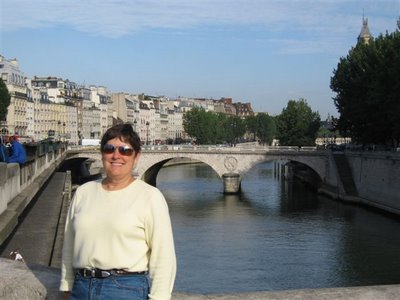
It has been named as a World Heritage Site. The river runs through and around the city for about seven and a half miles. Today it is navigable into the city and Paris has a major sea port. It also has some of the most widely recognized tourist attractions in the world. We did the tourist thing.
Paris Tourism says that the Eiffel Tower is the most visited and viewed tourist attraction in the world. If that wasn’t true before, I’m sure after the day we visited there it became a fact. I never saw so many people in one place. It was built for the World Exhibition in 1889.

The construction took about two years. It is 1051 feet high and the four feet form a 415 foot square. There are 1652 steps up to the third level (we didn’t verify that), and they say that you can see for 45 miles from that third level. The Tower has had many practical uses. It served as a military transmitter during WWI. In 1916 it became the beacon for the trans-Atlantic radio-telephone service. Today it serves as a meteorological and aircraft navigation station as well as TV and radio transmitter.
We saved the Louvre for an early morning visit so it would not be so crowded.

WRONG!!! It is amazing how crowded a place that big can get. At times it was hard to walk. It was not a pleasant time, and we did not spend as much time there as we had thought we would. We did see the Mona Lisa and Venus de Milo.
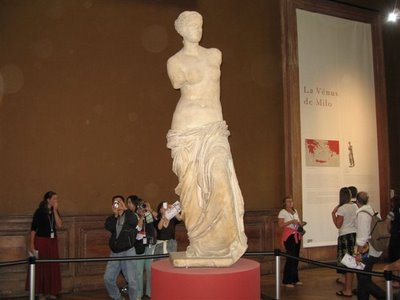
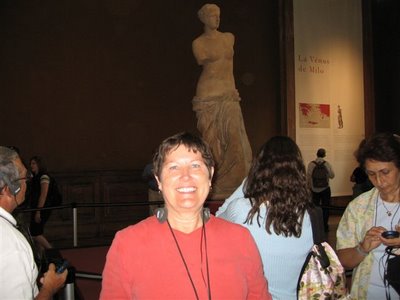
They are two famous ones which I recognized. Everything there was famous for the work or the artist. Before the Louvre became the greatest art gallery in the world it was the largest Royal Palace in the world. There is supposed to be 18 miles of corridors in the buildings.
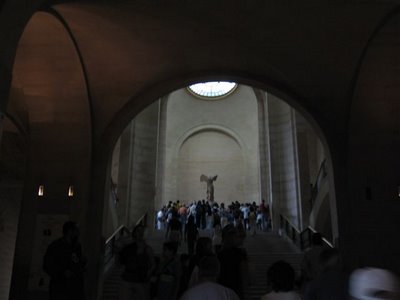
The courtyard and the architecture of the building are impressive. The initial building took place from 1204 until 1223, but many additions were added before it became a museum in 1793. By that time the Royal inhabitants has amassed one of the richest art collections in the world. Most of the great artists of the world are represented here, as is the 140 carat Regent Diamond among the Crown Jewels.
The Cathedral of Notre Dame is awe inspiring. We spent quite a lot of time just looking at the sight.
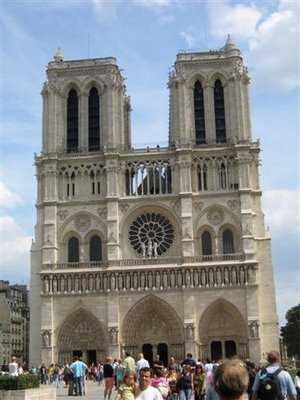
It is the culmination of several temples to pagan Cernunnos, guardian to the underworld, Roman Jupiter and several Christian Churches. It was built between 1163 and 1330. The building is 425 feet long, with towers that are 223 feet tall.
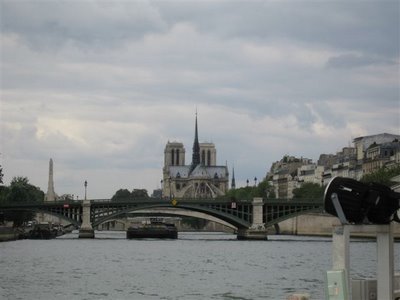
The spire which was added sometime during the 19th century is about 300 feet high. I think that we took more pictures of the Cathedral than anything else we have seen. With its dimensions it is impossible with our camera to get the entire building in one picture. We took a River Seine boat cruise and perhaps the best picture we got of the Cathedral was from the boat.
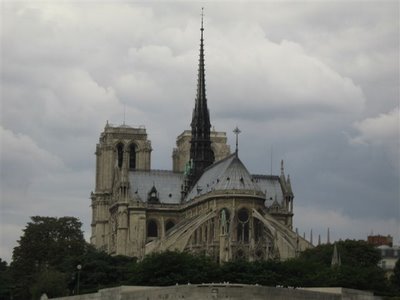
Nothing was done by chance. All the arches and towers have significance, usually dedicated to some religious figure or event from the Bible.
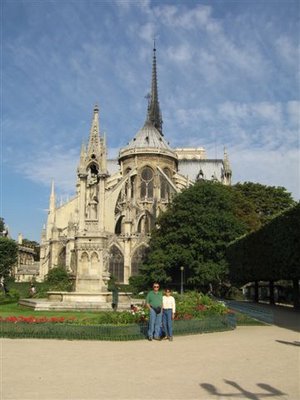
The organ is one of the largest in the world. It has 108 stops and 7800 pipes. The Cathedral is open to the public and may be toured under certain restrictions. Outside the Cathedral is a statue of Charlemagne honoring his period of rule and his contributions to France.

The Arc De Triomphe stands at the top of the Champs-Elysees. Next to the Eiffel Tower it is probably the most recognized of the sights in Paris.
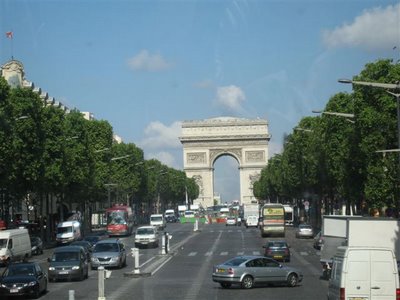
It’s construction was commissioned by Napoleon in 1806 to celebrate his military victories. It is a Roman style Arch with sculptures and carvings depicting various battles, and it is inscribed with the names of 660 Generals who fought in 128 battles. The Monument is 165 feett high and 150 feet wide. There are stairs and an elevator which lead to the roof where you can view the sights of Paris. Under the Arch is the Tomb of the Unknown Soldier.
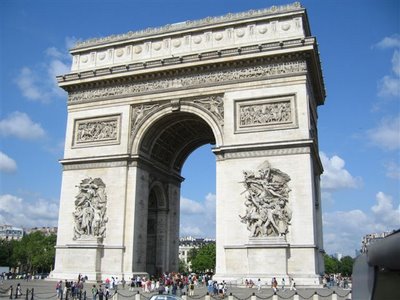
The Arch was not completed when Napoleon was deposed and was finished by his nephew Louis-Philippe in 1836. Napoleon died in exile and never saw the completion, but in his honor, his ashes were hauled through the Arch by a military ambulance.
The Conciergerie was the Roman Governors mansion and later the Royal Palace of King Clovis. Later the southern half became the home of the Parliament and Supreme Court.
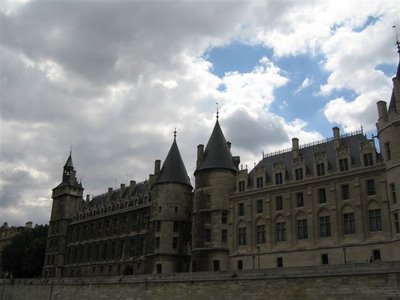
The Northern half was the Conciergerie and Prison. This is where Marie-Antoinette spent her last days before being beheaded.
Mary and I visited some book stores on the Blvd St. Michel. At the head of the Blvd is the Cathedral of St. Michel.
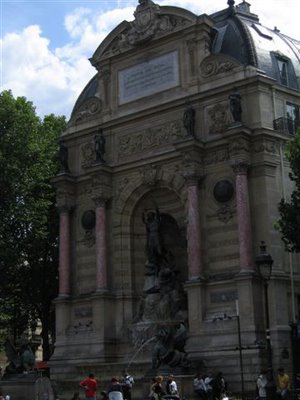
This is the main shopping are for a section of the city called the Latin Quarter.
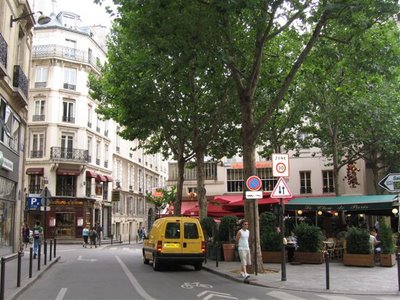
This is the home of students of the University of Paris and the Sorbonne. Both Universities were founded during the mid 1200's. From the 13th century until the 19th century Latin was the only language used in the University grounds. Towering over the Latin Quarter is the Pantheon which has become a symbol of the section.
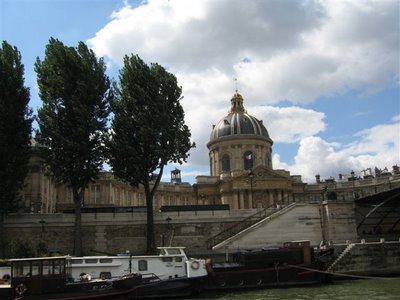
It is the church completed in 1789 by Louis XV. It is in the shape of a Greek cross with a large dome and columns. It is very prominent on the skyline of the Latin Quarter.
Perhaps the most well known Boulevard in the world is the Champs –Elyees.
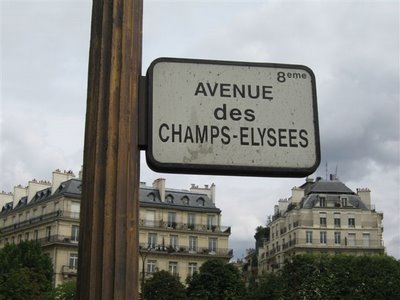
In 1667 it was laid out by Louis as a promenade. It ran far out into the country through farm land and pastures. I gather that the Elysian Fields is where the name came from. It became the fashion to drive the Blvd on warm afternoon outings.
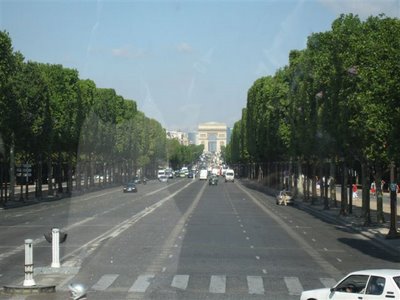
Napoleon chose the hilltop at the end of the Blvd for the Arc de Triomphe. Today the Champs-Elysees a far cry from the open farm land. A short part of the lower end of the Blvd is still wooded and used as parks. The major part of its length is taken up by office building, very expensive shops and restaurants.
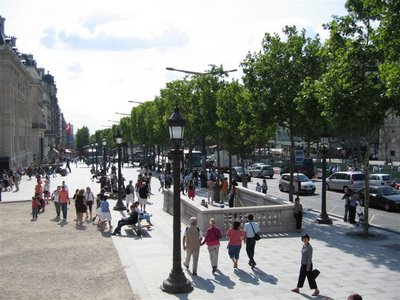
Along the way you pass the Palais d’ Elysee, which is the home of the President of France. Now used as museums are the Grand Palais and Petit Palais.

If you go south on the Blvd you reach the Place de la Concorde.
The Place de la Concorde is a square laid out between 1755 and 1775 by Louis XV. It has buildings only on one side. On the North are two elegant hotels, the Hotel de la Marine and the Hotel de Crillon. To the east is a park with tiled fountains in which children can play and a tiled pond for them to sail toy boats and watch the water fowl. On the South is the River Seine with the Pont de la Concorde (bridge).
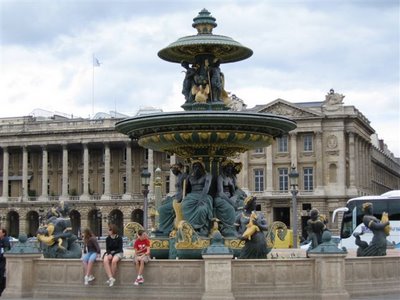
This bridge was built in 1791 using the stones from the newly demolished Bastille prison. To the West is an entrance to the Champs-Elysees. The central part of the square is shaped like an octagon and has a statue at each point representing eight of France's greatest cities. There are some fountains and a tall obelisk which was carved in 1250 BC and given to France by the Ottoman Governor of Egypt in 1831.

This is the oldest thing we have seen I believe. During much of the French Revolution this square was home to the guillotine and both Louis XVI and Marie-Antoinette were beheaded here.
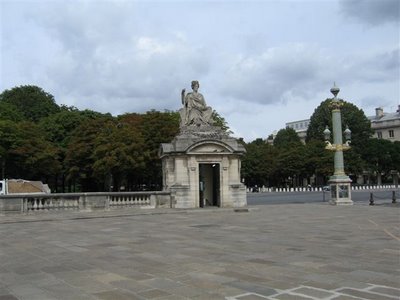
I have been putting off writing this because it is so long. I decided to make it as brief as I could. I guess I failed, but I could have included a lot more than I did. This entire week with visits to Berlin, Amsterdam, Brussels and Paris has been a great experience. We have seen things which we will never forget.
We arrived in Paris from Brussels in the early evening on Wednesday. We took a taxi from the train station to our Hostel. We had to do that because I got our reservations near the wrong train station. I wanted to be near the central train station, but I got close to the Nord Station. After we learned to use the Metro (underground rail system) it didn’t really make a lot of difference, because it was only about a ten minute ride from our house to the central station. All the tourists activities are centered around the central train station. Central indicating what they call “City Center” over here. We have learned that if you get lost you can usually find you way to about anything if you can get to the city center. We are staying in an old hotel building. We were on the 2nd floor and I’m glad because there was no elevator. This is the first place we have stayed where the breakfast they served did not appeal to us. Fortunately, there was a McDonalds across the street which had egg McMuffins.
Our hotel didn’t have internet access either. They directed us to an internet café, but it was expensive and you had to use their computers because they did not have wireless. On our first visit there we talked to a lady who told us the McDonalds had free WiFi, but she didn’t have a laptop. We used their free internet the rest of our visit and ate breakfast there everyday. Between the McDonalds and our hotel was an entrance to the Metro. We had only to walk about a hundred yards to get to it. We bought forty eight hour passes which allowed us to ride as much as we wanted to for one price. On Thursday morning we took a city bus tour. It was an on and off tour so we got off and took pictures and got back on the next bus which came along. That works well because the start another tour about every 15 or 20 minutes, so you never have to wait a long time to get another ride. On the second day, Friday, we rode the Metro and walked a lot going back to spend more time at places of special interest.
The history of Paris goes all the way back to a Celtic Gaul Parisii settlement which dates back to about 300 BC. Paris went through rule by the Gauls, the Romans under Julius Caesar, and defended themselves against the Attila the Hun and later the Vikings. Finally in 987 a King was named and the Capetian dynasty was founded. Paris and France became a factor in the world. By the mid 1200’s Paris had two universities. In the mid 1300’s Paris became a walled city when Charles V needed more defense. By the mid 1500”s the quays along the river were built and there were street lights. The 1830’s saw the first French railroad and by 1900 there was a metro underground system in Paris. So much for that little bit of history teacher jumping up on me.
Today Paris has a population of 2,250,000 and covers an area of 40 square miles. They entertain about half that number of tourists each month on average. Tourism is Frances’ biggest money producer with the Fashion industry and its accessories being second as a cash cow. The River Seine has been a critical part of Frances commerce since the quays were built in the 1500’s.

It has been named as a World Heritage Site. The river runs through and around the city for about seven and a half miles. Today it is navigable into the city and Paris has a major sea port. It also has some of the most widely recognized tourist attractions in the world. We did the tourist thing.
Paris Tourism says that the Eiffel Tower is the most visited and viewed tourist attraction in the world. If that wasn’t true before, I’m sure after the day we visited there it became a fact. I never saw so many people in one place. It was built for the World Exhibition in 1889.

The construction took about two years. It is 1051 feet high and the four feet form a 415 foot square. There are 1652 steps up to the third level (we didn’t verify that), and they say that you can see for 45 miles from that third level. The Tower has had many practical uses. It served as a military transmitter during WWI. In 1916 it became the beacon for the trans-Atlantic radio-telephone service. Today it serves as a meteorological and aircraft navigation station as well as TV and radio transmitter.
We saved the Louvre for an early morning visit so it would not be so crowded.

WRONG!!! It is amazing how crowded a place that big can get. At times it was hard to walk. It was not a pleasant time, and we did not spend as much time there as we had thought we would. We did see the Mona Lisa and Venus de Milo.


They are two famous ones which I recognized. Everything there was famous for the work or the artist. Before the Louvre became the greatest art gallery in the world it was the largest Royal Palace in the world. There is supposed to be 18 miles of corridors in the buildings.

The courtyard and the architecture of the building are impressive. The initial building took place from 1204 until 1223, but many additions were added before it became a museum in 1793. By that time the Royal inhabitants has amassed one of the richest art collections in the world. Most of the great artists of the world are represented here, as is the 140 carat Regent Diamond among the Crown Jewels.
The Cathedral of Notre Dame is awe inspiring. We spent quite a lot of time just looking at the sight.

It is the culmination of several temples to pagan Cernunnos, guardian to the underworld, Roman Jupiter and several Christian Churches. It was built between 1163 and 1330. The building is 425 feet long, with towers that are 223 feet tall.

The spire which was added sometime during the 19th century is about 300 feet high. I think that we took more pictures of the Cathedral than anything else we have seen. With its dimensions it is impossible with our camera to get the entire building in one picture. We took a River Seine boat cruise and perhaps the best picture we got of the Cathedral was from the boat.

Nothing was done by chance. All the arches and towers have significance, usually dedicated to some religious figure or event from the Bible.

The organ is one of the largest in the world. It has 108 stops and 7800 pipes. The Cathedral is open to the public and may be toured under certain restrictions. Outside the Cathedral is a statue of Charlemagne honoring his period of rule and his contributions to France.

The Arc De Triomphe stands at the top of the Champs-Elysees. Next to the Eiffel Tower it is probably the most recognized of the sights in Paris.

It’s construction was commissioned by Napoleon in 1806 to celebrate his military victories. It is a Roman style Arch with sculptures and carvings depicting various battles, and it is inscribed with the names of 660 Generals who fought in 128 battles. The Monument is 165 feett high and 150 feet wide. There are stairs and an elevator which lead to the roof where you can view the sights of Paris. Under the Arch is the Tomb of the Unknown Soldier.

The Arch was not completed when Napoleon was deposed and was finished by his nephew Louis-Philippe in 1836. Napoleon died in exile and never saw the completion, but in his honor, his ashes were hauled through the Arch by a military ambulance.
The Conciergerie was the Roman Governors mansion and later the Royal Palace of King Clovis. Later the southern half became the home of the Parliament and Supreme Court.

The Northern half was the Conciergerie and Prison. This is where Marie-Antoinette spent her last days before being beheaded.
Mary and I visited some book stores on the Blvd St. Michel. At the head of the Blvd is the Cathedral of St. Michel.

This is the main shopping are for a section of the city called the Latin Quarter.

This is the home of students of the University of Paris and the Sorbonne. Both Universities were founded during the mid 1200's. From the 13th century until the 19th century Latin was the only language used in the University grounds. Towering over the Latin Quarter is the Pantheon which has become a symbol of the section.

It is the church completed in 1789 by Louis XV. It is in the shape of a Greek cross with a large dome and columns. It is very prominent on the skyline of the Latin Quarter.
Perhaps the most well known Boulevard in the world is the Champs –Elyees.

In 1667 it was laid out by Louis as a promenade. It ran far out into the country through farm land and pastures. I gather that the Elysian Fields is where the name came from. It became the fashion to drive the Blvd on warm afternoon outings.

Napoleon chose the hilltop at the end of the Blvd for the Arc de Triomphe. Today the Champs-Elysees a far cry from the open farm land. A short part of the lower end of the Blvd is still wooded and used as parks. The major part of its length is taken up by office building, very expensive shops and restaurants.

Along the way you pass the Palais d’ Elysee, which is the home of the President of France. Now used as museums are the Grand Palais and Petit Palais.

If you go south on the Blvd you reach the Place de la Concorde.
The Place de la Concorde is a square laid out between 1755 and 1775 by Louis XV. It has buildings only on one side. On the North are two elegant hotels, the Hotel de la Marine and the Hotel de Crillon. To the east is a park with tiled fountains in which children can play and a tiled pond for them to sail toy boats and watch the water fowl. On the South is the River Seine with the Pont de la Concorde (bridge).

This bridge was built in 1791 using the stones from the newly demolished Bastille prison. To the West is an entrance to the Champs-Elysees. The central part of the square is shaped like an octagon and has a statue at each point representing eight of France's greatest cities. There are some fountains and a tall obelisk which was carved in 1250 BC and given to France by the Ottoman Governor of Egypt in 1831.

This is the oldest thing we have seen I believe. During much of the French Revolution this square was home to the guillotine and both Louis XVI and Marie-Antoinette were beheaded here.

I have been putting off writing this because it is so long. I decided to make it as brief as I could. I guess I failed, but I could have included a lot more than I did. This entire week with visits to Berlin, Amsterdam, Brussels and Paris has been a great experience. We have seen things which we will never forget.